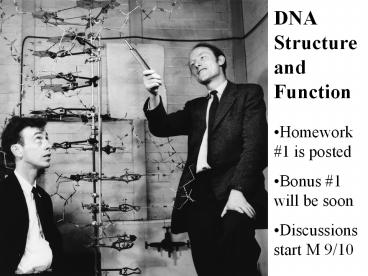DNA Structure and Function - PowerPoint PPT Presentation
Title:
DNA Structure and Function
Description:
Title: No Slide Title Author: Stuart Reichler Last modified by: Stuart Reichler Created Date: 6/5/2002 2:53:09 PM Document presentation format: On-screen Show – PowerPoint PPT presentation
Number of Views:34
Avg rating:3.0/5.0
Title: DNA Structure and Function
1
DNA Structure and Function
- Homework 1 is posted
- Bonus 1 will be soon
- Discussions start M 9/10
2
How is information transferred between cells?
Fig 7.2
Different strains of bacteria are injected into
mice.
3
How is information transferred between cells?
Fig 7.2
4
How is information transferred between cells?
Fig 7.2
5
How is information transferred between cells?
Fig 7.2
6
Fig 7.2
What has happened to the bacteria?
7
- DNA is the transforming agent
Fig 7.3
8
The Structure of DNA
If these two can win a Nobel prize
James Watson and Francis Crick
9
Data showing uniformity of DNA structure.
Rosalind Franklin
10
Fig 7.58.2
Nucleotides have a sugar backbone
11
Fig 7.5 8.2
This subtle difference in structure has profound
effects.
12
Fig 7.58.2
Plus four different bases
13
Together with a phosphate nucleotide
Fig 7.5
14
Fig 7.5
Together with a phosphate nucleotide
15
Fig 7.8
Connect nucleotides by covalent bond
strand (notice 5-3 bond)
16
Fig 7.8
DNA is typically double stranded and
anti-parallel The strands are connected by
hydrogen bonds
17
Data showing uniformity of DNA structure.
Rosalind Franklin
18
Figure 7-10
Fig 7.8
- Base pairing in DNA
19
Figure 7-9
Fig 7.9
- Two representations of the DNA double helix
20
Fig 8.11
DNA stores information, but does not do anything.
The information must be expressed to be useful.
21
The relationship between DNA and genes
a gene
promoter
coding region
terminator
non-gene DNA
22
DNA Composition
- In humans
- Each cell contains 6 billion base pairs of DNA.
- This DNA is 2 meters long and 2 nm wide.
- 97 does not directly code for amino acids
- In a single human cell only about 3-5 of genes
are expressed at a time.
23
Length of human DNA in each cell
Width of DNA
24
DNA Composition
- In humans
- Each cell contains 6 billion base pairs of DNA.
- This DNA is 2 meters long and 2 nm wide.
- 3 directly codes for amino acids
- 10 is genes
- In a single human cell only about 5-10 of genes
are expressed at a time.
25
The relationship between DNA and genes
a gene - DNA used to produce RNA or protein
promoter
coding region
terminator
non-gene DNA
26
Five Perspectives of a Gene
27
Genes act as units of hereditystoring and
passing on information.
28
Genes act as units of heredity storing and
passing on information.
29
Genes are seen as a cause of disease
30
Genes are seen as a cause of disease
31
Sickle-cell anemia is caused by a single
nucleotide change in the hemoglobin gene
Fig 6.5
32
Fig 8.11
Genes code for proteins
33
- Five Perspectives of Genes
- Genes act as units of heredity
- Genes are seen as a cause of disease
- Genes code for proteins(we stopped here, and
will continue with the 5 gene perspectives on F) - Genes act as switches, controlling development
- Genes are replicators (selfish gene)






























